
Todai-ji Temple: Home to the Great Buddha of Nara - And a Nose Hole That Brings You Luck!?
- Written by: WESTPLAN
Todai-ji Temple, home to the iconic Great Buddha of Nara, is one of the Kansai region's top sightseeing destinations. Some say a trip to Nara isn't complete without visiting this impressive temple complex.
From the majestic Great South Gate to the awe-inspiring Great Buddha Hall, Todai-ji offers a rich experience, including various halls and a museum filled with treasures. Take your time exploring all that this historic site has to offer!
(Main image: DMstudio House / Shutterstock.com)
- Table of Contents
-
- What Kind of Place is Nara's Todai-ji Temple?
- The Daibutsuden: One of the Largest Wooden Structures in the World
- Meet the Great Buddha of Nara: Japan's Largest Buddha Statue
- Nigatsu-do Hall: Famous for Its Water-Drawing Ceremony
- Take a Matcha Break in the Ryuudo-do
- Hokke-do Hall: Filled with a Plethora of Statues
- Todai-ji Museum: Five Exhibition Rooms Worth Checking Out!
- Original Temple Goods Are Also in High Demand
What Kind of Place is Nara's Todai-ji Temple?
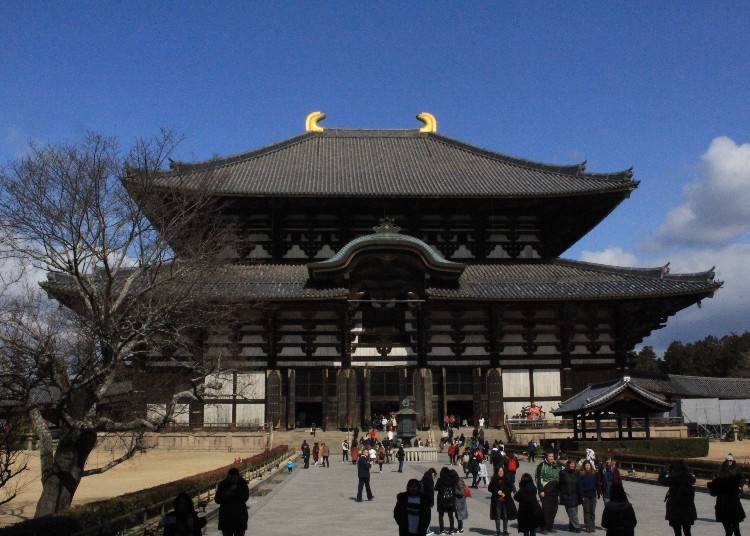
Todai-ji Temple, also known as "Konkomyo-shitenno-gokoku-no-tera," was built during the Nara period by Emperor Shomu. The emperor commissioned the Daibutsu-sama (Giant Buddha), also called Rushanabutsu, as a prayer for prosperity, following Buddhist teachings. In 752, a grand ceremony was held to consecrate the statue and "open its eyes."
The temple, named "Todai-ji" (東大寺) for its location in eastern Heijo-kyo (the then-capital), became one of Japan's largest and serves as the main temple of the Kegon sect of Buddhism. It's also famous for the water-drawing ceremony at Nigatsu-do Hall, which signals the start of spring in Nara.
Kongo Rikishi Statues Guard Todai-ji's Great South Gate
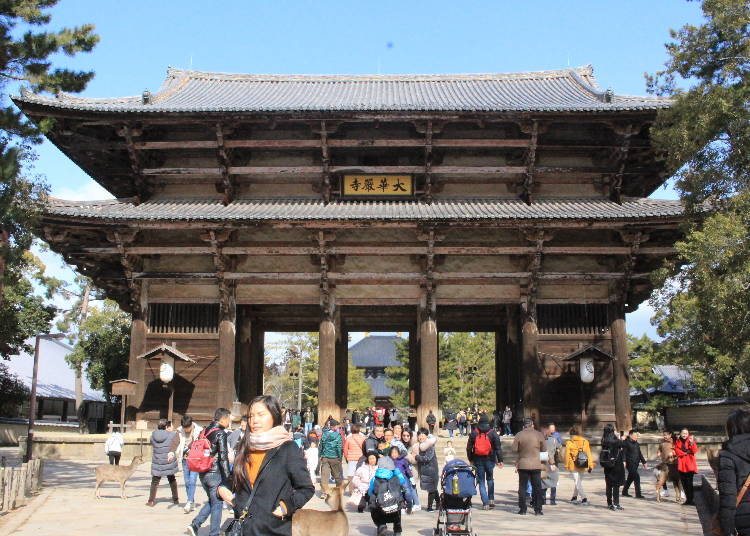
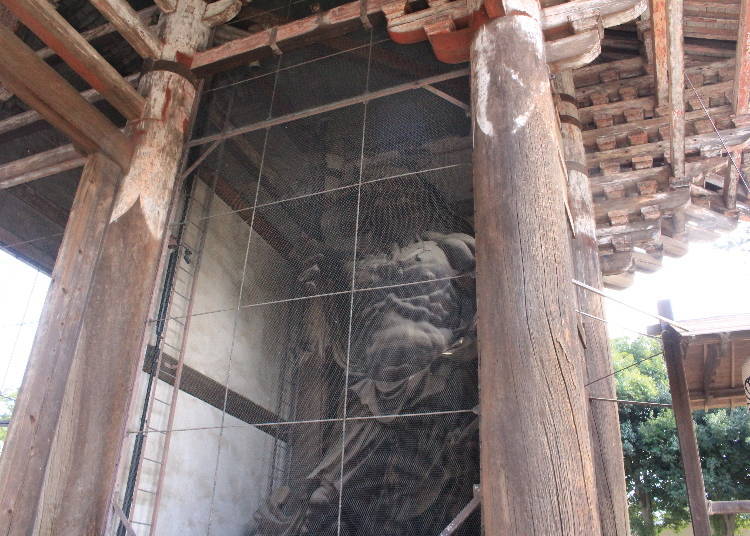
As you walk towards Todai-ji Temple, you’ll pass through the impressive Nandai-mon, or Great South Gate, a national treasure. Standing 25 meters tall, the gate features the must-see "Kongo Rikishi" statues, crafted by renowned sculptors Unkei and Kaikei. These powerful, muscled figures are striking and imposing.
Typically, the two Nio guardian gods face the main gate, with Agyo on the right, mouth open, and Ungyo on the left, mouth closed. However, at Todai-ji's Great South Gate, the statues are reversed from the usual arrangement.
Rebuilt in the Kamakura era by monk Chogen Shonin after a fire, the gate uses a unique construction method with thick, straight pillars and horizontal crossbeams (nuki), appearing two-layered from the outside but hollow within. Don’t forget to look up as you pass through!
The Daibutsuden: One of the Largest Wooden Structures in the World
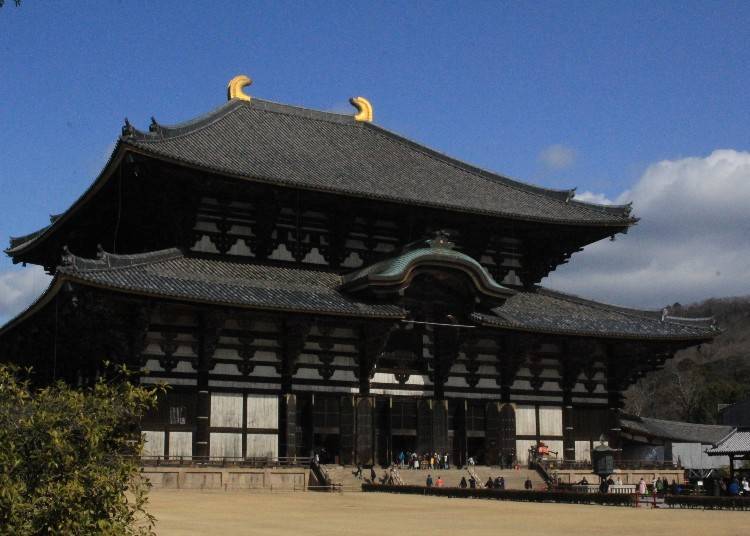
Todai-ji Temple's Daibutsuden ("Great Buddha Hall") is an impressive wooden structure, measuring about 57 meters wide, 50 meters deep, and 48 meters tall, and is renowned as one of the largest wooden buildings in the world. Although the current hall, rebuilt in the Edo period, is still massive, it was even larger when originally constructed.
For the best photos, stand slightly to the left of the main gate, from the hallway accessible after paying the admission fee. In front of the hall stands the octagonal gilt-bronze lantern, a national treasure and a rare relic from the temple’s original construction.
Meet the Great Buddha of Nara: Japan's Largest Buddha Statue
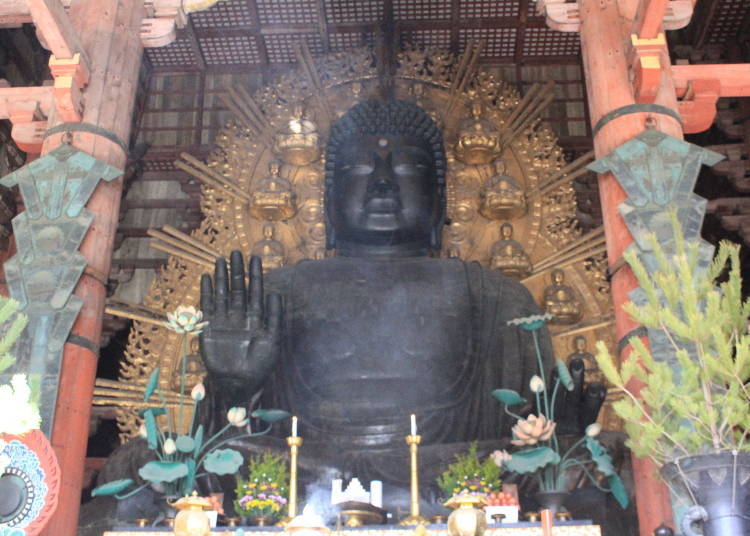
As you enter the Great Buddha Hall, you'll be greeted by the imposing figure of Nara's Daibutsu-sama, the Great Buddha. Officially named "Rushanabutsu" (the Buddha who illuminates the world), this 15-meter-tall statue with a 5-meter-long face is the spiritual symbol of the Kegon sect of Buddhism. It is said that half of the population at the time contributed to its construction.
Although the statue has undergone several restorations, some original Nara-era elements, like the flower petals and parts of the stomach, remain. You can approach and pray to the Daibutsu-sama from the front, left, or right.
Try Passing Through the Hole in the Pillar!

At the back right of the Great Buddha Hall, behind the giant Buddha statue, there's a pillar with a hole said to be the size of the Buddha's nostril.
Those who can pass through it are believed to be granted good health and protection from bad luck. This popular activity attracts schoolchildren and international tourists alike, with many eager to capture the moment on camera. The hole measures about 37 by 30 centimeters and is 110 centimeters deep, rectangular in shape.
Also in Nara's Great Buddha Hall, you can find models of the temple and purchasable omamori good luck charms, a Todai-ji goshuin seal stamp, and more.
Don't Miss the Shitennoji Statues in the Kaidan-in!
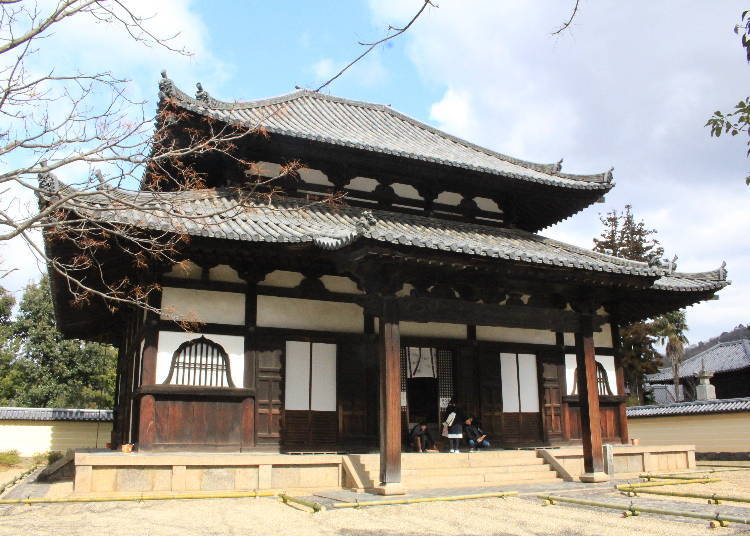
Exit the Great Buddha Hall and head west along the temple path to Kaidan-in. This hall, built by Chinese monk Ganjin Wajo, houses Nara-period statues of the Shitenno, the Four Heavenly Kings of Buddhism, one in each corner.
The statues represent Jikokuten (east), Zochoten (south), Komokuten (west), and Tamonten (north), all considered masterpieces. Each stands atop a demon, gazing into the distance, with intricate details in their expressions, musculature, and the folds of their clothing—remarkably carved from wood. Among the four, the most popular is the strikingly handsome Komokuten.
Nigatsu-do Hall: Famous for Its Water-Drawing Ceremony
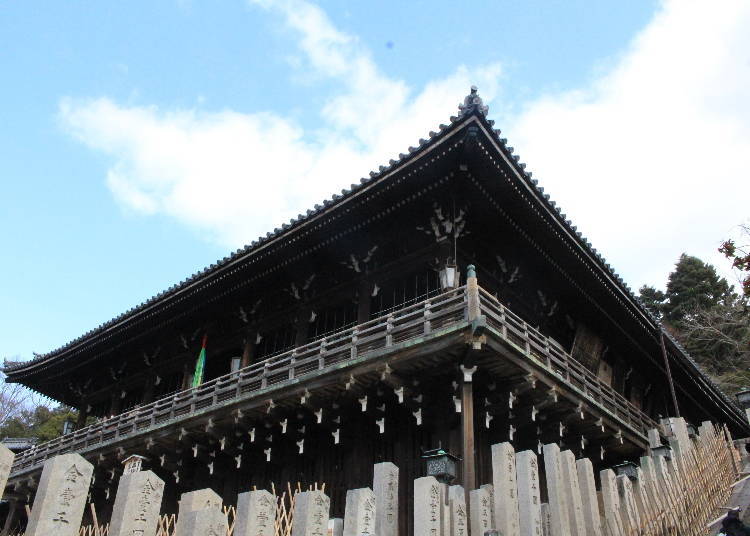
From Kaidan-do, head to the rear temple road behind the Great Buddha Hall. The cobblestone path creates an amazing atmosphere. Next, enter the national treasure Nigatsu-do Hall, perched on an elevated platform in the temple's eastern rear. From here, you’ll enjoy a stunning view of the entire Nara Basin, especially beautiful in the evening.
Nigatsu-do is named for the Buddhist water-gathering ritual held in the second month ("nigatsu") of the old calendar, now observed from March 1-14. Each night, torches light up the hall as monks perform their nightly walk, sending fiery sparks into the air. Before the flames rise, announcements about the water-gathering ritual are made in English and Chinese.
Take a Matcha Break in the Ryuudo-do
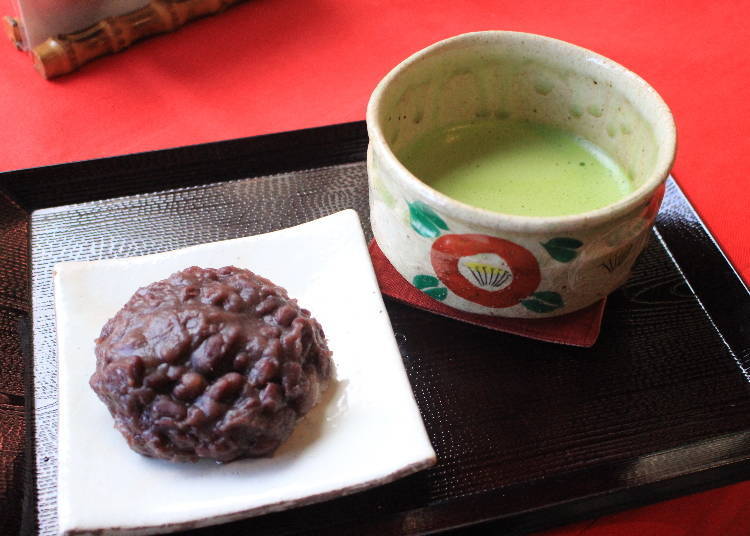
"Ryuudo-do" is a tea shop located south of Nigatsu-do Hall, famous for Todai-ji's secret recipe Gyoho miso, which is exclusive to the shop, along with its original sweets. The highlight is the exquisite warabi-mochi, made fresh in-house. You can enjoy it chilled in summer or warm in winter, with its soft texture complemented by lightly sweet kinako soybean powder and special kuromitsu brown sugar syrup.
International tourists also love the hand-made ohagi and matcha. The red bean paste, made from Hokkaido-grown azuki beans, is both delicious and satisfying.
Take Home Some Secret-Recipe Miso as a Souvenir!

A highly recommended souvenir is the "O-mizutori Gyoho Miso," a snackable miso paste made from an ancient Todai-ji Temple secret recipe. Crafted with ingredients like gobo root, soybeans, and sesame, often used by secluded monks to enhance their spiritual power, this miso is exclusive to Ryuudo-do and unavailable anywhere else.
Its robust flavor pairs perfectly with warm rice, cucumber, tofu, denraku, or even on its own with a sake drink. This versatile gift makes an excellent souvenir. (90g/650 yen, 180g/1300 yen, all tax included)
-
Ryuudo-do龍美堂
- Address Todai-ji Nigatsu-do Southern Tea House, 1-406 Zoshi-cho, Nara City, Nara
- Phone Number 0742-23-6285
・Hours: 9 AM–5 PM
・Closed: Irregular
Hokke-do Hall: Filled with a Plethora of Statues

After descending from Nigatsu-do, head to Hokke-do Hall (also called Sangatsu-do). This area was the temple's central hub before Nara's giant Buddha was built, and Hokke-do is Todai-ji's oldest surviving structure from the Nara period, possibly even a relic of Todai-ji's predecessor, Konshu-ji Temple.
The hall enshrines Fukuukensaku Kannon, a deity said to save all people. The statue has 8 arms, wears a silver crown adorned with hundreds of gems, and holds a rope. Inside, you’ll also find 10 national treasures and important cultural assets, including Kongo Rikishi and Shitennoji statues. The 3-4 meter tall statues are truly awe-inspiring and a must-see at the temple.
Todai-ji Museum: Five Exhibition Rooms Worth Checking Out!

The Todaiji Museum, located within the Todai-ji Temple Cultural Center, features five main exhibition rooms, each with a unique theme for easy exploration.
Room 1 focuses on Todai-ji’s founding era, while Room 2 displays a fascinating collection, including a young Buddha statue, an important cultural artifact statue of Senju Kannon Bosatsu, a Bosatsu Hanka statue, and various Buddhist statues, crafts, and artwork.
Visiting the museum before exploring the temple halls can deepen your understanding of Todai-ji's history and significance. The museum's information center also provides pamphlets about Todai-ji and other Nara City and Prefecture attractions in three languages.
Original Temple Goods Are Also in High Demand
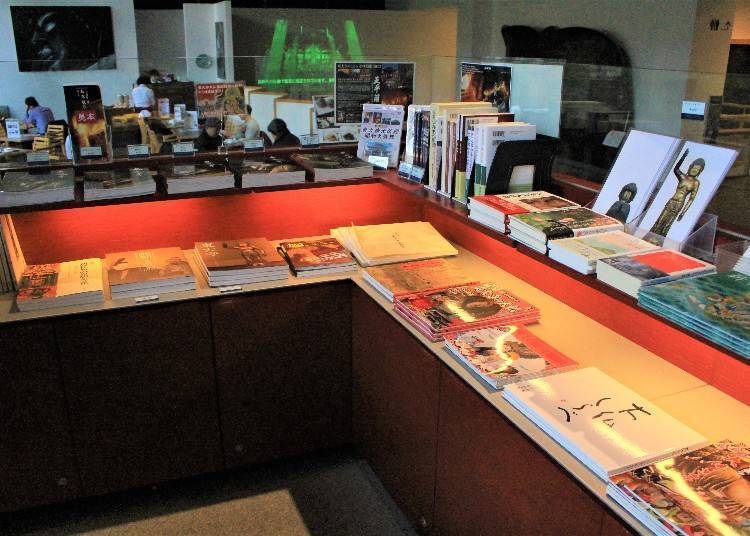

Popular Todaiji Temple Souvenirs
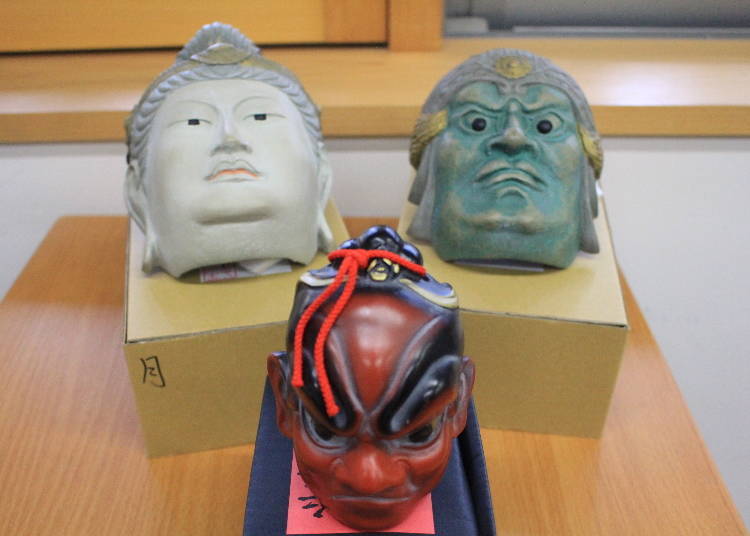
Let's introduce some popular souvenirs available exclusively at the museum shop. First are the temple guidebooks, available in Japanese, English, Chinese, Korean, French, and German. Picture books and other publications are also popular choices.
Next, check out the temple’s original file sleeves, with 14 different designs featuring the Daibutsu-sama, Kongo Rikishi statues, Nikko and Gekko Bosatsu statues, and other Buddhist figures and Shoso-in images.
Another favorite, especially among repeat customers, is the Todai-ji Temple original bath salts. Lastly, ceramic bells and masks of the Nio guardians, particularly the Jikokuten and Gekko Bosatsu masks, are sought after by international tourists.
Todaiji Temple Goshuin: Don't Forget to Get a Temple Seal Stamp!

At Todai-ji Temple, you can receive goshuin stamps at not only the Great Buddha Hall but also the other various halls. At the Great Buddha Hall, since the temple is of the Kegon sect, in the middle of the stamp is a "kegon" flower symbol and the Sanskrit characters for Buddha.
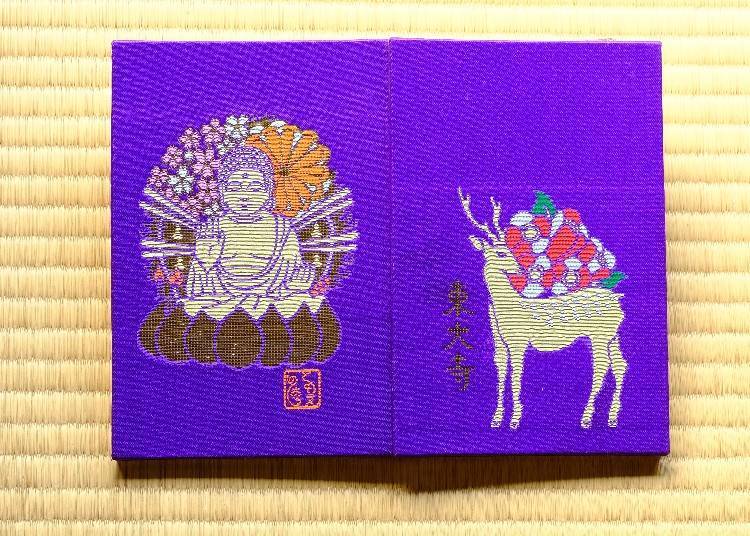
Todai-ji Temple offers 18 different types of stamps, including those featuring the four deities of Kaidan-do Hall and the 11-faced Kannon of Nigatsu-do Hall. The original stamp book, adorned with a chrysanthemum seal, and its matching stamp bookcase are both stunning.
Pictured is the Todai-ji Temple's original temple seal stamp book, with a cover designed by singer and artist Tomoe Shinohara. The noble purple booklet, featuring illustrations of the Daibutsu-sama, Nara deer, and camellia flowers, is available for purchase at the Great Buddha Hall and other locations.
-

-
Address
406-1 Zoshicho, Nara City, Nara Prefecture, 630-8587
View Map -
Nearest Station
Kintetsunara Station (Kintetsu-nara Line)
20 minutes on foot
- Phone Number 0742-22-5511
-
Address
406-1 Zoshicho, Nara City, Nara Prefecture, 630-8587
Kiko Matsuda, Keiko Kimura, Risa Tsushi, and a team of female writers familiar with Kansai. We love eating, drinking and traveling! We share fun information based on our experiences.
- Area
- Category
*Prices and options mentioned are subject to change.
*Unless stated otherwise, all prices include tax.
Popular Tours & Activitiess
Recommended places for you
-

ISHIDAYA Hanare
Yakiniku
Kobe, Sannomiya, Kitano
-

Kanzenkoshitsuyakinikutabehodai Gyugyu Paradise Sannomiya
Yakiniku
Kobe, Sannomiya, Kitano
-

Kambei Sannomiyahonten
Yakiniku
Kobe, Sannomiya, Kitano
-

Jukuseiniku-to Namamottsuarera Nikubaru Italian Nikutaria Sannomiya
Izakaya
Kobe, Sannomiya, Kitano
-

Osaka Aquarium KAIYUKAN
Zoos, Aquariums & Botanical Gardens
USJ, Nanko Port
-
Goods

Yoshida Gennojo-Roho Kyoto Buddhist Altars
Gift Shops
Nijo Castle, Kyoto Imperial Palace
-

Best Things to Do and See Around Kyoto & Osaka in September: Events and Festivals in Kansai
-

Curious About Sake? I Visited a Sake Brewery in Japan and Here's What I Learned
-

History and Sustainable Brewing: World-Renowned Fukuju Sake at Kobe Shushinkan
by: WESTPLAN
-

November Events in Kansai: Fun Festivals, Food, and Things to Do in Kyoto & Osaka
-
Ad

Recharge and Relax with a Healing Getaway at Kamenoi Hotel Toba
-
Ad

Café Bahnhof in Osaka: The home-roasted coffee that captivated G20 leaders!
Inspiration for Accommodations
-

Spacious Family Hotel in Namba: 20 Comfortable Stays for Family Fun
-

Charming Hotels to Enjoy the Spectacular Views of Arashiyama's Autumn Leaves from Your Room
-

Experience Stunning Views of Osaka Castle from Private Spaces: Top Hotels Near Osaka Castle
-

Recommended by Visitors! Arashiyama's Best-Rated Hotels
-

Family-Friendly Universal Studios Japan Hotel with Excellent Access
-

Enjoy a Comfortable Stay in Osaka! 10 Hotels with Convenient Airport Shuttle Services
-

Top 10 Recommended Hotels Near Namba Station with Great Access
-

Enjoy Night Views from Your Room! Recommended Hotels in Namba Area
-

The Best of Japan: 11 Major Cities Every Traveler Should Visit
-

Autumn in Japan 2025: Fall Foliage Forecast & Where to Enjoy the Colorful Leaves (+Tour Info)
-

(Video) Walking Tour along Narita Omotesando - Quaint Historical Village near Narita Airport!
by: Victor Gonzalez
-

Tokyo Train Map: Your Essential Guide to Subways and Railways
-

38 Best Things to Do in Kyoto: See, Eat, and Shop Your Way Through Japan's Cultural Capital
-

Why Osaka Tennoji Zoo is So Popular with Foreign Tourists (Guide & Highlights)
- #best gourmet Osaka
- #things to do Osaka
- #what to do in kyoto
- #what to bring to japan
- #best gourmet Kyoto
- #new years in Osaka
- #what to buy in nanba
- #Visiting Osaka
- #onsen tattoo friendly arima
- #daiso
- #Visiting Kyoto
- #best japanese soft drinks
- #japanese fashion culture
- #japanese convenience store snacks
- #japanese nail trends

















